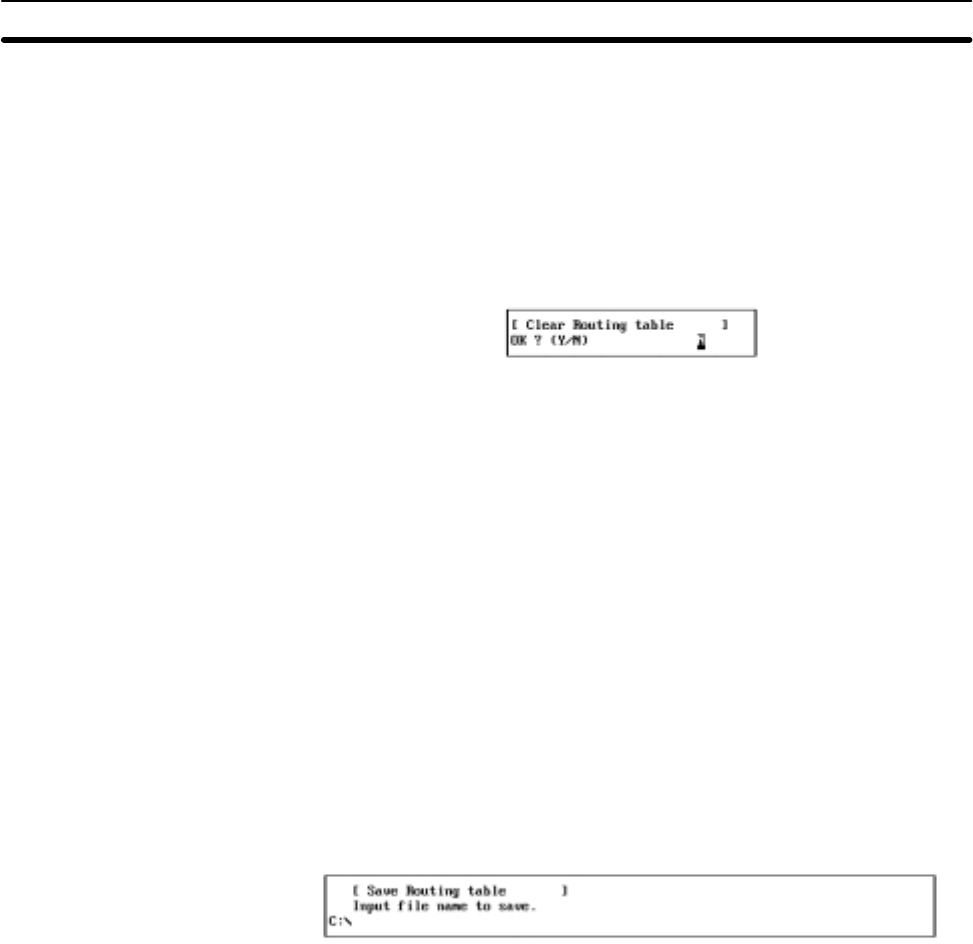
5-5SectionR: Routing Table
93
5-5-7 Initializing Routing Tables — C: Initialize
“C: Initialize” is use to initialize routing tables.
Note 1) “C: Initialize” initializes the routing tables in the computer memory. To initial-
ize the routing tables that have been set at a node, select “D: Delete” from
the Routing Table Menu.
2) Initializing the routing tables makes them unspecified (blank).
1, 2, 3... 1. Select “C: Initialize” from the Routing Table Menu. The following confirma-
tion message will be displayed.
2. To initialize the routing tables, press “Y” and then the Enter Key. The routing
tables will be initialized.
To cancel the initialization processing, press “N” and then the Enter Key.
5-5-8 Saving Routing Tables as a File — S: Save
“S: Save” is used to save routing tables as a file.
Note 1) Unless saved, the routing tables in the memory will be lost when the Control-
ler Link Support Software is exited.
2) If routing tables have been modified but have not yet been saved, a con-
firmation message will be displayed when you attempt to exit the Controller
Link Support Software.
3) “S: Save” is used to save routing tables residing in the computer memory. To
save the routing tables that have already been set at a node, select
“T: Transfer” from the Routing Table Menu to read the tables to the comput-
er, then save them.
4) Routing table files for the Controller Link Support Software are compatible
with those for the SYSMAC Support Software and the SYSMAC LINK Sup-
port Utility. Therefore, routing files can be transferred between them.
1, 2, 3... 1. Select “S: Save” from the Routing Table Menu.
2. Specify the file name (including the directory name) to be saved. Enter the
file name with Alphanumeric Keys, then press the Enter Key.
The extension of the file name to be saved must be .RTG. If the extension is
omitted, .RTG will be automatically added as an extension.
When this window appears, the data directory specified in “System setup”
will be displayed as the destination. The Insert, Backspace, and Delete
Keys can be used to correct the characters displayed.
Alternatively, you can press the F8 (Files) Key to display the File Name List
Screen and then select a file name from the screen.
If an existing file name is specified, a confirmation message will be dis-
played to ask you to check whether the file can be overwritten. Press “Y” to
overwrite the file or press “N” to cancel the save processing, then press the
Enter Key.
3. Enter a title to be attached to the file. Enter a title with Alphanumeric Keys,
then press the Enter Key. Up to 30 characters can be entered as the title.
The Insert, Backspace, and Delete Keys can be used to correct the charac-
ters displayed.
If no title is required, just press the Enter Key.
The file will be saved.
